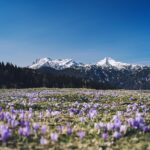The natural world has long been a source of inspiration, wisdom, and healing for humanity. Its cycles of growth, destruction, and renewal mirror our own struggles and triumphs, offering profound lessons on resilience. In times of personal or collective recovery—whether from illness, trauma, environmental degradation, or societal upheaval—the environment provides a blueprint for bouncing back stronger than before. This article explores how nature’s resilience can guide us in our own journeys of recovery, highlighting key principles and actionable insights.
Understanding Nature’s Resilience
Resilience is the ability to withstand adversity, adapt to change, and emerge transformed. In ecosystems, resilience manifests as the capacity to recover from disturbances such as wildfires, floods, or deforestation. These processes are not merely about survival but also about thriving in new ways. By observing nature’s strategies for resilience, we can glean valuable lessons applicable to human recovery.
1. Adaptation Over Resistance
One of nature’s most powerful traits is its ability to adapt rather than resist change. For example:
- After a forest fire, certain plant species like lodgepole pines release seeds only when exposed to high heat, ensuring regeneration.
- Wetlands absorb excess water during storms, preventing flooding downstream while replenishing groundwater supplies.
This principle teaches us that resisting inevitable changes often leads to exhaustion. Instead, embracing flexibility and finding creative solutions allows us to navigate challenges more effectively.
2. Interconnectedness Strengthens Resilience
Ecosystems thrive because they are interconnected networks where every organism plays a role. Bees pollinate flowers, fungi decompose organic matter, and predators regulate prey populations. When one element falters, others step in to maintain balance.
- Coral reefs, though fragile, recover faster when surrounded by diverse marine life.
- Prairie grasslands rely on deep root systems that stabilize soil and support neighboring plants during droughts.
In human terms, this underscores the importance of community and collaboration in recovery. Building strong support networks ensures we have resources and encouragement when facing difficulties.
3. Regeneration Through Destruction
Paradoxically, destruction often precedes renewal in nature. Forest fires clear out dead vegetation, allowing sunlight to reach the forest floor and stimulate new growth. Similarly, volcanic eruptions create nutrient-rich soils ideal for agriculture.
- The 1980 eruption of Mount St. Helens devastated the surrounding area but eventually gave rise to a flourishing ecosystem teeming with biodiversity.
- Floodplains deposit silt after inundations, enriching farmland for future harvests.
These examples remind us that setbacks can pave the way for transformation if we approach them with patience and perspective.
Lessons from Specific Ecosystems
Different ecosystems offer unique insights into resilience, each reflecting distinct aspects of recovery.
1. Forests: Patience and Perseverance
Forests embody patience and perseverance, qualities essential for long-term recovery. Old-growth forests take centuries to mature, yet their slow growth results in unparalleled stability and richness.
- Redwood Forests: Coastal redwoods, some of the tallest trees on Earth, regenerate through burls—dormant buds that sprout after damage.
- Rainforests: Despite constant threats from logging and climate change, rainforests demonstrate remarkable regenerative power when protected.
For individuals, this lesson emphasizes the value of incremental progress. Small, consistent efforts compound over time, leading to significant achievements.
2. Deserts: Thriving Amid Scarcity
Deserts teach us how to thrive under harsh conditions, relying on minimal resources to survive and even flourish.
- Cacti: These iconic desert plants store water in their thick stems and bloom vibrantly after rare rains.
- Animals: Creatures like kangaroo rats extract moisture from seeds and conserve energy during extreme temperatures.
In human contexts, this translates to resourcefulness and ingenuity. Even in scarcity, we can find opportunities to innovate and persevere.
3. Rivers: Flow and Flexibility
Rivers symbolize flow and flexibility, adapting their course as needed without losing momentum.
- Meandering Paths: Rivers naturally shift direction over time, carving new channels while maintaining forward movement.
- Floodplains: Temporary flooding nourishes adjacent lands, demonstrating how disruptions can benefit broader systems.
This metaphor encourages us to embrace uncertainty and remain open to redirection. Life’s detours may lead to unexpected blessings.
Applying Nature’s Principles to Personal Recovery
The parallels between natural ecosystems and human experiences are striking. Here’s how we can apply these principles to foster personal resilience.
1. Embrace Change as Opportunity
Just as forests regenerate after fires, we too can view setbacks as catalysts for growth. Whether recovering from illness, loss, or failure, reframing challenges as stepping stones builds mental fortitude.
- Practice mindfulness to stay present and reduce resistance to change.
- Set small, achievable goals to rebuild confidence and momentum.
2. Cultivate Strong Support Networks
Like interconnected ecosystems, humans thrive within supportive communities. Surround yourself with people who uplift and empower you.
- Seek therapy or counseling to process emotions and gain professional guidance.
- Join peer support groups to connect with others navigating similar paths.
3. Focus on What You Can Control
Nature adapts to uncontrollable forces by focusing on what it can influence. Similarly, concentrate on actions within your control rather than dwelling on external factors.
- Develop healthy habits like exercise, proper nutrition, and adequate sleep.
- Engage in hobbies or activities that bring joy and fulfillment.
4. Allow Time for Healing
Recovery, like ecological restoration, requires time and patience. Rushing the process often leads to setbacks.
- Celebrate milestones along the way, no matter how small.
- Trust that gradual improvements will culminate in lasting transformation.
Environmental Recovery: A Reflection of Human Resilience
Nature’s resilience isn’t just a model for individual recovery—it also mirrors humanity’s collective ability to heal the planet. Environmental recovery initiatives demonstrate how intentional action can restore damaged ecosystems and mitigate climate impacts.
1. Reforestation Projects
Planting trees restores habitats, sequesters carbon, and combats soil erosion. Successful reforestation projects in places like Costa Rica and Ethiopia showcase the potential for large-scale ecological healing.
- Community involvement ensures local buy-in and long-term success.
- Native species selection promotes biodiversity and ecosystem health.
2. Urban Green Spaces
Cities worldwide are incorporating green spaces to combat urban heat islands, improve air quality, and enhance residents’ well-being.
- Rooftop gardens and vertical forests integrate nature into dense urban environments.
- Parks and green corridors provide sanctuaries for wildlife and recreation for humans.
3. Ocean Conservation Efforts
Marine conservation highlights the importance of protecting fragile ecosystems. Coral reef restoration programs use techniques like coral farming and transplantation to revive dying reefs.
- Public education campaigns raise awareness about sustainable fishing practices.
- International agreements address pollution and overfishing on a global scale.
These efforts illustrate how human intervention, guided by nature’s principles, can reverse environmental damage and promote coexistence.
Challenges in Learning from Nature
While nature offers invaluable lessons, applying them isn’t always straightforward. Several barriers must be acknowledged and addressed.
1. Short-Term Thinking
Modern society often prioritizes immediate results over long-term sustainability. Overcoming this mindset requires shifting cultural values toward patience and foresight.
2. Lack of Awareness
Many people remain unaware of nature’s intricate workings and the lessons it holds. Educational outreach and experiential learning can bridge this gap.
3. Economic Pressures
Financial constraints sometimes force individuals and organizations to prioritize profit over resilience. Advocating for policies that incentivize sustainable practices is crucial.
Success Stories: Nature-Inspired Recovery
Real-world examples highlight the transformative power of nature-inspired resilience.
Case Study 1: Loess Plateau Restoration
Once barren and eroded, China’s Loess Plateau underwent a massive restoration project involving terracing, reforestation, and sustainable agriculture. Today, it supports thriving ecosystems and improved livelihoods for millions.
Case Study 2: Yellowstone Wolf Reintroduction
The reintroduction of wolves to Yellowstone National Park restored ecological balance by controlling elk populations and revitalizing riparian zones. This initiative exemplifies how targeted interventions can yield cascading benefits.
Case Study 3: Post-Hurricane New Orleans
After Hurricane Katrina devastated New Orleans, community-led wetland restoration projects helped buffer against future storms while fostering social cohesion.
Conclusion: Drawing Strength from Nature
Nature’s resilience serves as both a teacher and a testament to the enduring power of life. By studying its patterns and principles, we can navigate our own recoveries with greater grace and determination. Whether healing ourselves, rebuilding communities, or restoring ecosystems, the lessons of nature remind us that adversity is not an endpoint but a beginning—a chance to grow stronger, wiser, and more connected.
As we face mounting global challenges, let us draw inspiration from the forests, deserts, rivers, and oceans that sustain us. Their resilience proves that renewal is possible, even in the face of seemingly insurmountable odds.
Frequently Asked Questions (FAQs)
-
What does resilience mean in nature?
Resilience in nature refers to the ability of ecosystems to recover from disturbances and maintain functionality. -
How can I learn from nature’s resilience?
Observe natural processes, study ecosystems, and reflect on how their strategies apply to personal or societal challenges. -
Which ecosystems are most resilient?
Diverse ecosystems like rainforests, wetlands, and coral reefs tend to exhibit higher resilience due to their complexity. -
Can nature help me cope with stress?
Yes, spending time in nature reduces cortisol levels, improves mood, and enhances overall well-being. -
What role do humans play in environmental recovery?
Humans can restore ecosystems through reforestation, conservation, and sustainable practices. -
How does biodiversity contribute to resilience?
Biodiversity increases an ecosystem’s capacity to adapt to changes and recover from disruptions. -
Are there books or documentaries about nature’s resilience?
Recommended resources include Braiding Sweetgrass by Robin Wall Kimmerer and documentaries like Our Planet . -
Why is patience important in recovery?
Patience allows time for healing and adaptation, ensuring sustainable progress rather than rushed fixes. -
How can I support environmental recovery efforts?
Volunteer, donate to conservation organizations, advocate for policy changes, and adopt eco-friendly habits. -
What is the connection between personal and environmental recovery?
Both involve healing, adaptation, and sustainable growth, emphasizing the interconnectedness of all life.










